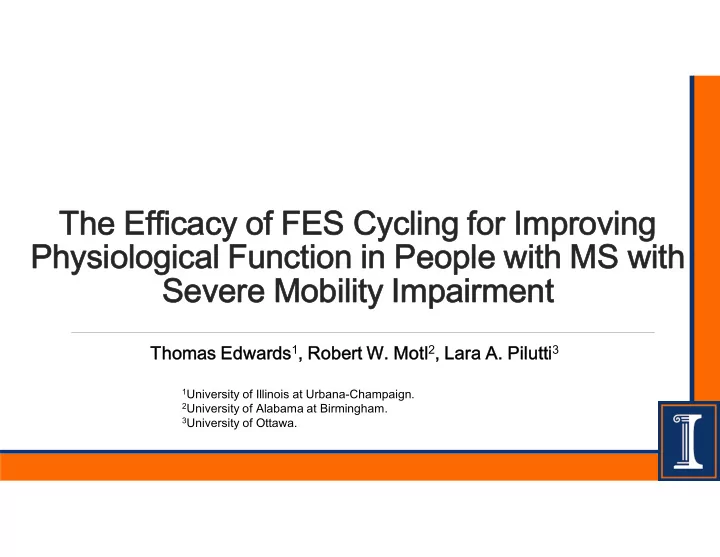

The Efficacy of FES Cycling for Improving Physiological Function in People with MS with Severe Mobility Impairment Thomas Edwards 1 , Robert W. Motl 2 , Lara A. Pilutti 3 1 University of Illinois at Urbana-Champaign. 2 University of Alabama at Birmingham. 3 University of Ottawa.
Disclosures None to declare
Exercise and MS • Exercise training has been an effective method for improving: • Walking • Physical fitness • Fatigue • Mood • QoL Latimer-Cheung et al., 2013; Motl & Sandroff, 2015
Exercise and MS • Previous research primarily focused on individuals with mild to moderate disability • Conventional exercise approaches may present challenges • Alternative, adapted exercise modalities should be considered
Mobility Disability in MS
Functional Electrical Stimulation (FES) • Exercise modality coupled with a electrical stimulation • FES-cycling • Benefits reported in other populations with mobility impairment • Spinal cord injury and stroke • Preliminary evidence for safety and efficacy of FES-cycling in MS
Other Populations • Benefits largely established in SCI and stroke • Improved walking, gait, strength, spasticity, bone & skin health, metabolism Bauer et al., 2015 Hakansson et al., 2011
MS and FES Outcome Measure Baseline Change after 6 Percentage months change T25FW (sec) 27.3 17.4 36% 2MW (m) 35.4 39.9 13% TUG (sec) 36.5 28.4 -22% SSWS (m/min) 15 20.3 35% Knee Extension (lbs) 40.8 46.9 15% Knee Flexion (lbs) 22.7 27.1 19% SF-36 41.8 47.3 13% Ratchford et al., 2010
Objectives • Single-blinded, randomized pilot clinical trial for examining the efficacy of 6-months of supervised FES cycling versus a passive cycling condition • Primary outcomes: walking and physical fitness
Methods: Participants • Inclusion criteria • Exclusion Criteria • EDSS=5.5 to 6.5 • epilepsy • physically inactive • a pacemaker • relapse free ≥30 days • an implanted defibrillator • confirmed diagnosis of MS • an unstable fracture • asymptomatic • surgical screws or pins • physician approval • ability to tolerate FES cycling.
Methods: Design FES cycling Recruitment Allocation Analysis and Screening Passive cycling Baseline Midpoint Final (0 months) (3 months) (6 months) ASSESSMENTS Pilutti et al., 2016
Methods: Intervention Month 1 Month 2 Months 3-6 10-15 Minutes 20-25 Minutes 30-40 Minutes 3 Days/week 3 Days/week 3 Days/week • FES Group: Received stim …. • Passive Group: No voluntary cycling • Effects sizes calculated (Cohen’s d ) to determine intervention effects Pilutti et al., 2016
Methods: Outcomes • Walking Ability • Walking speed Timed 25-Foot Walk (T25FW) • Walking endurance 2-minute walk (2MW) • Agility Timed Up–and-Go test (TUG) • Physical Fitness • Muscular strength • Aerobic capacity
Results: Demographics FES (n=4) Passive (n=4) p-value Demographic Characteristics Age, y 57.3 (6.0) 48.5 (7.7) .12 Sex, n Women 3 3 - Men 1 1 - Height, cm 161.1 (10.4) 160.5 (9.2) .93 Weight, kg 70.6 (19.5) 85.8 (46.0) .56 BMI, kg/m2 27.2 (7.4) 32.1 (13.9) .56 Clinical Characteristics EDSS 6.1 (0.5) 6.25 (0.3) .67 Disease Duration, y 22.3 (5.3) 20.8 (8.5) .77
Results: Training • Average compliance=84.2% • Submaximal exercise session was characterized 63.5% of VO 2peak 57.3% of WR peak 76.4% of HR peak
Results: Mobility ES = - 0.30 ES = 0.20* ES = 0.38
Results: Fitness ES = 0.34 ES = 0.79
Results: Fitness ES = - 0.06 ES = 0.81*
Discussion: Mobility FES group • Result of increased physical • Improvements/maintenance fitness of all mobility outcome • Consistent with previous literature • Aerobic capacity and lower Passive group limb strength are associated with walking performance • Decline in all mobility (Sandroff et al, 2013) outcomes
Discussion: Fitness FES group • Prolonged aerobic stimulus • Improved/maintained contribute to aerobic fitness aerobic fitness • Improved knee extensor strength • Leg cycling pattern may explain difference in flexor/extensor strength Passive group • Decline in all fitness • Stimulation of compromised outcomes musculature increased muscle recruitment
Conclusions • FES cycling is an accessible, adapted form of exercise training • Provides an aerobic exercise stimulus • External stimulation may recruit compromised muscles • Improvements/maintenance of mobility and fitness
Acknowledgments • Clinical Exercise Neuroscience Lab • Exercise Neuroscience Research Lab • Dr. Lara Pilutti • Dr. Robert Motl
Thank you Questions?
Excluded (n=27) Assessed for • Did not meet inclusion eligibility (n=38) criteria (n=18) • Refused to participate (n=9) Randomized (n=11) FES Cycling group Passive Cycling Allocation (n = 6) group (n = 5) Analyzed (n=4) Analyzed (n=4) 6 Month Discontinued Discontinued Follow-up intervention (n=2) intervention (n=1)
Results: Mobility Variable Baseline 6 Month Mean Effect size Follow Up Change (0-6) (Cohen’s d) T25FW, m/s 0.60 (0.3) 0.70 (0.4) 0.10 0.3 FES TUG, s 29.7 (18.4) 25.0 (17.0) -4.76 -0.3 2MW, m 63.9 (36.6) 66.9 (39.2) 3.05 0.1 Variable Baseline 6 Month Mean Effect size Follow Up Change (0-6) (Cohen’s d) Passive T25FW, m/s 0.76 (0.4) 0.71 (0.4) -0.05 -0.1 TUG, s 31.6 (37.9) 35.3 (42.2) 3.65 0.1 2MW, m 75.2 (46.1) 70.0 (46.3) -5.18 -0.1
Results: Fitness Variable Baseline 6 Month Follow Mean Change Effect size Up (0-6) (Cohen’s d) VO 2 , ml/kg/min 15.2 (4.0) 16.0 (5.0) 0.73 0.2 FES WR, W 51.3 (10.3) 56.3 (17.5) 5.0 0.5 TTE, s 509 (103.7) 565.8 (169.3) 56.75 0.6 Flexor (Nm) 42.2 (24.7) 34.48 -7.7 -0.3 Extensor (Nm) 64.4 (15.1) 70.9 (30.0) 6.5 0.4 Variable Baseline 6 Month Follow Mean Change Effect size Up (0-6) (Cohen’s d) Passive VO 2 , ml/kg/min 16.4 (9.0) 14.9 (5.3) -1.5 -0.2 WR, W 67.5 (11.9) 63.8 (14.9) -3.8 -0.3 TTE, s 673.8 (156.5) 674.5 (151.4) 0.75 0.0 Flexor (Nm) 44.3 (14.9) 37.8 (16.5) -6.5 -0.4 Extensor (Nm) 115.2 (37.0) 100.6 (29.9) -14.6 -0.4
Recommend
More recommend